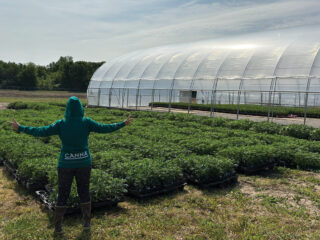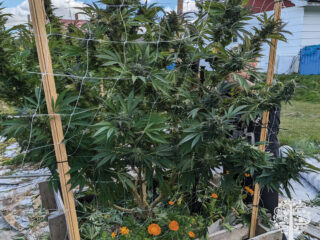From Saskatchewan to Alberta, then east to New Brunswick and now Ontario, Genevieve Newton refines her skills with every move she makes. Now, with seven years in Canada’s regulated cannabis industry, she’s taken on her biggest challenge yet – overseeing 50 acres of outdoor cannabis as Farm Supervisor at Mera Cannabis in St. Thomas, Ontario.
To indoor growers, she says get outside, and to corporate cannabis, she’s in, but only if it works with her lifestyle, keeping the passion alive while avoiding burnout. The Prairie-born Indigenous grower aligns work with personal purpose, and three months into her new role, riding tractors and toiling in the torrential rain and blistering sun, Newton is loving every minute as a ganja farmer.
Here’s what Genevieve Newton had to say from her Jeep office in the field.

How is the cultural aspect of the job, along with farming outdoors and working in the elements, unique from an indoor position?
GN: This morning, we were recognizing that today is Indigenous Peoples’ Day. I work with a lot of temp people from different cultures. So, not just today, but every day, we’re teaching each other about different words, different foods, and about what smudge is, and teaching people why we smudge – for protection and for cleansing. To clear the air and to keep everyone and everything happy and healthy.
Working outdoors is not for the faint of heart because you have to be willing to be out here in all sorts of weather conditions; you need to really love nature.
I started out here at the beginning of April, so we still had snow. May was just complete rain, rain, rain, here. We couldn’t get in any of the tractors – the disker, the cultivators, the tillers – nothing. We couldn’t do anything to the ground, so everything was late going in. I had wanted to start planting at the end of May, then we had an entire month of heat. It’s not ideal to be planting in 30-degree weather; we were praying for rain.
But the best thing you can do before hitting the ground is have them absolutely as healthy as possible so that they can withstand that kind of drought stress, that kind of heat stress. The wind all of a sudden decided to be crazy for a whole week. I’d race there in the morning and be running out there to make sure everyone’s still standing, and day after day, they’re still standing.
“Weed is resilient; I’m impressed by these plants. A bad day growing outside is still better than a medium day growing indoors.”
On the 100-acre farm, how many acres are in cultivation?
GN: I’d say we’re going to be taking up about half of that this year. So, 50 acres and then the other 50 we’re amending with organic inputs under the guidance of a consultant and scientist, and it’s like a three-to-five-year plan.
There are different strains going in first and then second. Because we have one tractor and one planter, you can only get so much done in a day. I received unrooted clones from a nursery, and we rooted them in an indoor facility and then transported them two weeks later into the hoop houses, and they acclimated fantastically.
“The Queen of Clones”; this year, I earned that title because I got 35,000 at once, while having to train a couple of people so that you could start being in two places at once, right? As soon as they moved into the hoop house, there’s another 35,000, so that will stagger the harvest. They’re getting two weeks of veg time and then out into the field.
I’ve been working with the guys from the nursery, Rick and Brad. They’ve been amazing at helping me, supporting me, guiding me. So, I’m picking it up; everything that I can get. It’s not my first rodeo with large-scale cannabis, but it is my first time using tractors, and I’m becoming a full-time farmer – a ganja farmer.

Let’s talk a little bit about your experience and your history. You were Canada’s 2023 Top Grower. You’ve just been headhunted. How did all of this come to be?
GN: I will start with when I was young and in my twenties, weed wasn’t even a thought in my mind. I’m from that generation where it was very taboo, just like any other drug. And I went into social work. I started my degree in Regina, but then ended up moving to Edmonton, and I finished over at the University of Alberta. That’s where I started my work with children and youth. I did that until 2018, then I decided to quit family services.
I was a couple of years into having been diagnosed with a type of ulcerative colitis, and marijuana was offered to me at a desperate time. And at that time, I was four years sober from all drugs and alcohol. It was a battle for me to decide to use that as medicine. But once I did, it saved my life physically. It doesn’t cure everything. But for the stomach issues, it cured it better than any pharmaceutical. It was so lifesaving to me and valuable.
“To say I came in hot is an understatement.”
I want to learn everything about it. I started putting it in foods and infusing it in different oils and butter. And I started growing because it got to be expensive. I love growing flowers and thought that weed is just another flower.
There wasn’t a lot of info at the time, and that’s the reason I started making these ridiculous YouTube videos on how to use an Instant Pot to infuse your oil, where you can decarb it at the same time and not have any smell if you’re in an apartment. Then on social media channels and podcasts, people wanted to interview me about home growing. That’s how I got my start. Which brings me back to 2018 when I quit my job as a social worker and became a horticulturalist.

Tell us about your time home growing in New Brunswick.
GN: I moved to New Brunswick on another beautiful farm, 66 acres, on the same land as the lady that turned out to be my best friend. Best case scenario, again.
Last season was my biggest harvest. My biggest plant – I got one kilogram of baggable bud off of it. I’ve been growing outside since I lived in Edmonton, so I had to get used to the different climate in New Brunswick.
I love the climate, it was better. Longer season, the flowers look better, the structure is better. But as soon as everything starts to get nice, hurricanes start hitting.
My plants get really big, and I had a few huge stalks that broke in half. The second year I prepared for it, I built a few structures, but I had these CBDs in the ground that were bigger than me, and they were flattened in 120-kilometer winds, and I ran out there in my pink robe, propping them back up with a wheelbarrow and cement blocks.
Last year, I built a Hügelkultur in a pallet-sized box. I built these structures with pieces of lumber and netting. There was zero loss because they were completely caged in.
“My passion is home growing, and I want people to know that I’m still home growing.”
My New Brunswick genetics traveled all the way with me like VIPs, and they are doing great. So, I might flower some things out!
Shout-out to all the women still grinding in cannabis.